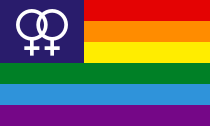
Back نسوية مثلية Arabic Feminismu lésbicu AST Lezbiyan feminizmi Azerbaijani সমকামী নারীবাদ Bengali/Bangla Teoria feminista lèsbica Catalan لێزبیان فێمێنیزم CKB Lesbický feminismus Czech Feminizmê lezbiyenan DIQ Λεσβιακός φεμινισμός Greek Lesba feminismo Esperanto
| Part of a series on |
| Lesbian feminism |
|---|
 |
|
|
| Part of a series on |
| Feminism |
|---|
 |
|
|


A labrys superimposed on the black triangle, set against a lavender-purple background.

Lesbian feminism is a cultural movement and critical perspective that encourages women to focus their efforts, attentions, relationships, and activities towards their fellow women rather than men, and often advocates lesbianism as the logical result of feminism.[2] Lesbian feminism was most influential in the 1970s and early 1980s, primarily in North America and Western Europe,[3] but began in the late 1960s[4] and arose out of dissatisfaction with the New Left, the Campaign for Homosexual Equality, sexism within the gay liberation movement, and homophobia within popular women's movements at the time.[5][6][3][4] Many of the supporters of Lesbianism were actually women involved in gay liberation who were tired of the sexism and centering of gay men within the community and lesbian women in the mainstream women's movement who were tired of the homophobia involved in it.[4]
Some key thinkers and activists include Charlotte Bunch, Rita Mae Brown, Adrienne Rich, Audre Lorde, Marilyn Frye, Mary Daly, Sheila Jeffreys, Barbara Smith, Pat Parker, Margaret Sloan-Hunter, Cheryl Clarke, Gloria E. Anzaldúa, Cherríe Moraga, Monique Wittig, and Sara Ahmed (although the last two are more commonly associated with the emergence of queer theory).
As stated by lesbian feminist Sheila Jeffreys, "Lesbian feminism emerged as a result of two developments: lesbians within the Women's liberation movement began to create a new, distinctively feminist lesbian politics, and lesbians in the Gay Liberation Front left to join up with their sisters".[7] According to Judy Rebick, a leading Canadian journalist and feminist activist, lesbians were and always have been "the heart of the women's movement", while their issues were "invisible" in the same movement.[8]
Lesbian feminism of color emerged as a response to lesbian feminism thought that failed to incorporate the issues of class and race as sources of oppression along with heterosexuality.
- ^ Stearn, William T. (May 1962). "The Origin of the Male and Female Symbols of Biology" (PDF). Taxon. 11 (4): 109–113. doi:10.2307/1217734. ISSN 0040-0262. JSTOR 1217734.
- ^ Rich, Adrienne (1986). "Compulsory Heterosexuality and Lesbian Existence (1980)". Blood, Bread, and Poetry: Selected Prose 1979-1985. W.W. Norton & Company. p. 23. ISBN 978-0-393-31162-4.
- ^ a b Faderman, Lillian (1981). "The Rise of Lesbian-Feminism". Surpassing the Love of Men: Romantic Friendship and Love Between Women from the Renaissance to the Present (1st ed.). New York: William Morrow and Company. pp. 377–391. ISBN 0-68803733X. LCCN 80024482.
- ^ a b c McCammon, Holly J.; Taylor, Verta; Reger, Jo; Einwohner, Rachel L., eds. (2017). "The Turn toward Socialist, Radical, and Lesbian Feminisms". The Oxford Handbook of U.S. Women's Social Movement Activism. Oxford University Press. pp. 89–108. doi:10.1093/oxfordhb/9780190204204.013.4. ISBN 978-0190204204.
- ^ DuBois, Ellen. "Feminism Old Wave and New Wave". The Feminist eZine. Lilith Press Magazine. Retrieved 28 May 2007.
- ^ DuBois, Ellen (September 22, 2016). "Feminism Old Wave and New Wave (1971)". Chicago Women's Liberation Union.
- ^ Jeffreys, Sheila (2003). Unpacking Queer Politics: A Lesbian Feminist Perspective (1st ed.). Cambridge, UK: Polity. p. 19. ISBN 978-0745628370.
- ^ Rebick, Judy. "Feminism in a neo-liberal age". Research Initiative on International Activism. University of Technology Sydney. Archived from the original on May 26, 2005. Retrieved March 23, 2012.